 Technology peripherals
Technology peripherals
 AI
AI
 Throughput increased by 30 times: CV pipeline moves toward full-stack parallelization
Throughput increased by 30 times: CV pipeline moves toward full-stack parallelization
Throughput increased by 30 times: CV pipeline moves toward full-stack parallelization

Introduction
John Ousterhout, a Stanford professor and inventor of the Tcl language, once wrote a book "The Philosophy of Software Design", which systematically discussed the general principles of software design. and methodology, the core point of the entire book is: the core of software design is to reduce complexity.
In fact, this point of view also applies to software design involving underlying hardware adaptation.
Take visual model development as an example. In the past visual model development process, people generally paid more attention to the optimization of the model itself to improve speed and effect. However, people pay little attention to the image pre-processing (pre-processing) and post-processing stages.
When model calculation, that is, the main stage of model training and inference, becomes more and more efficient, the pre- and post-processing stages of images increasingly become the performance bottleneck of image processing tasks.
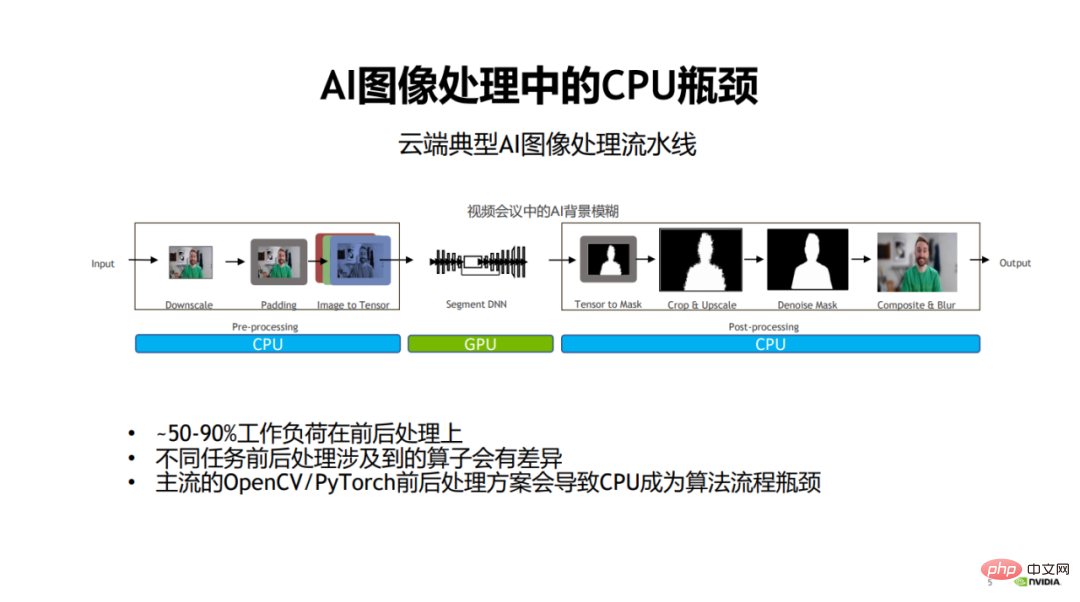
Specifically, in the traditional image processing process, the pre- and post-processing parts are usually operated by the CPU. , this will result in 50% to more than 90% of the workload in the entire process being related to pre- and post-processing, and thus they will become the performance bottleneck of the entire algorithm process.
1. Limitations of mainstream CV libraries
The above problems are currently on the market The main limitation of mainstream CV libraries in application scenarios is that inconsistency in dependence on underlying hardware leads to complexity and performance bottlenecks. As John Ousterhout summed up the causes of complexity: Complexity stems from dependencies.
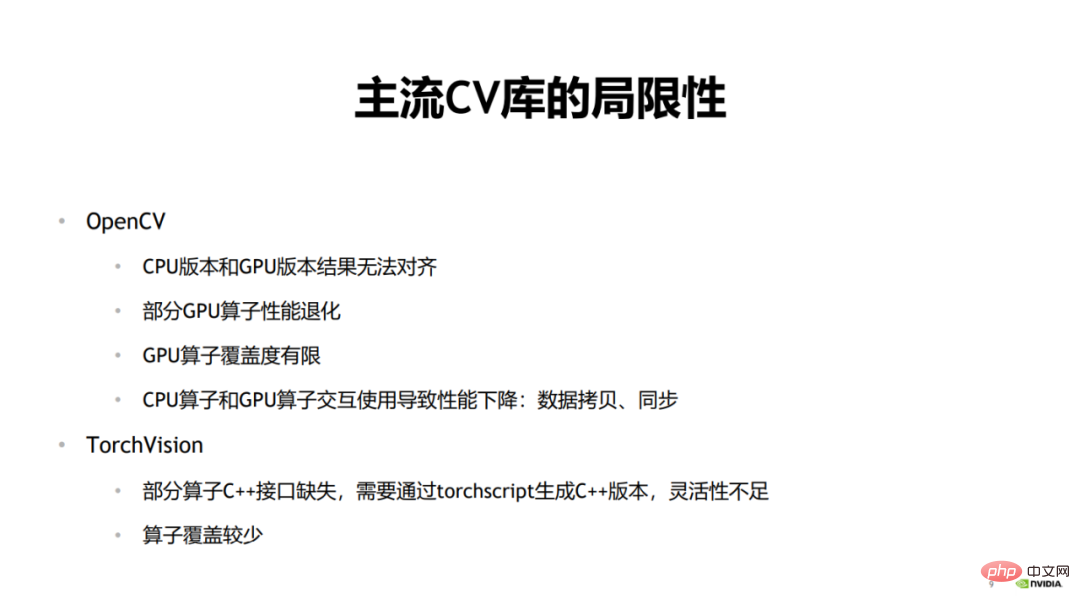
TorchVision When doing model inference, some operators lack C interfaces, resulting in a lack of flexibility when calling. If you want to generate a C version, you must generate it via TorchScript. This will cause a lot of inconvenience in use, because inserting operators from other libraries in the middle of the process for interactive use will bring extra overhead and workload. Another disadvantage of TorchVision is that the operator coverage is not high.
The above are the limitations of the current mainstream CV libraries.
2. Unified CV pipeline
Since the performance bottleneck of pre- and post-processing mainly lies in the use of CPU calculations, and the model The technology of using GPU in the computing stage has become increasingly mature.
#So, a natural solution is to use GPU to accelerate pre- and post-processing, which will greatly improve the performance of the entire algorithm pipeline.
To this end, NVIDIA and ByteDance jointly open sourced the image preprocessing operator library CV-CUDA. CV-CUDA can run efficiently on GPU, and the operator speed can reach about a hundred times that of OpenCV.
On January 15, 2023, from 9:30 to 11:30, the "CV-CUDA First Open Class" hosted by NVIDIA invited 3 students from NVIDIA, ByteDance, and Sina Weibo Technical experts (Zhang Yi, Sheng Yiyao, Pang Feng) shared in-depth on related topics. This article summarizes the essence of the speeches of the three experts. 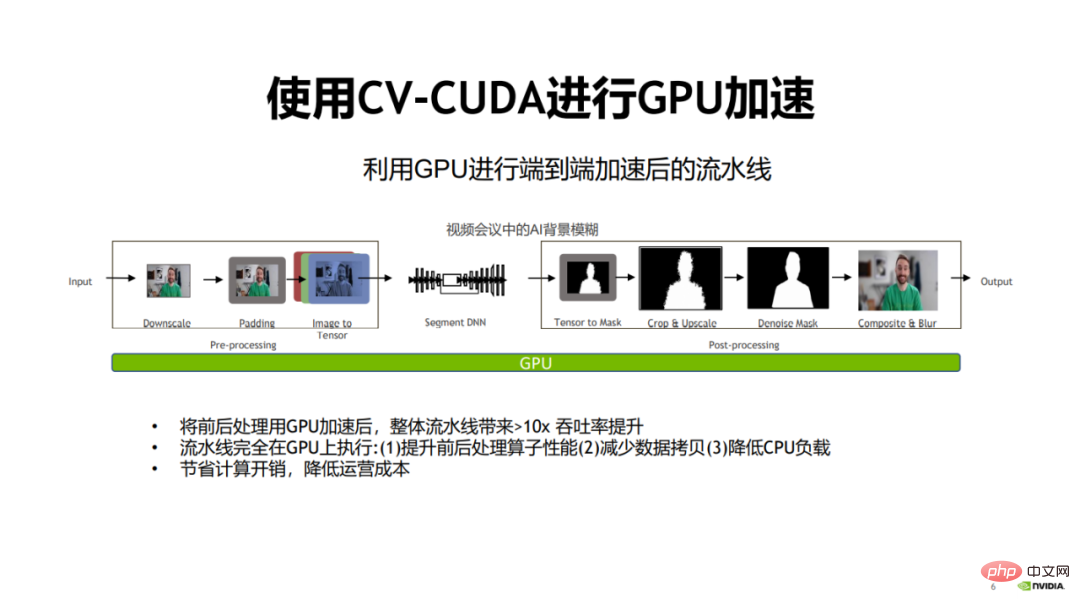
There are many benefits to using GPU instead of CPU. First of all, after the pre- and post-processing operators are migrated to the GPU, the computational efficiency of the operators can be improved.
Secondly, since all processes are performed on the GPU, data copying between the CPU and GPU can be reduced.
Finally, after migrating the CPU load to the GPU, the CPU load can be reduced and the CPU can be used to process other tasks that require complex logic.
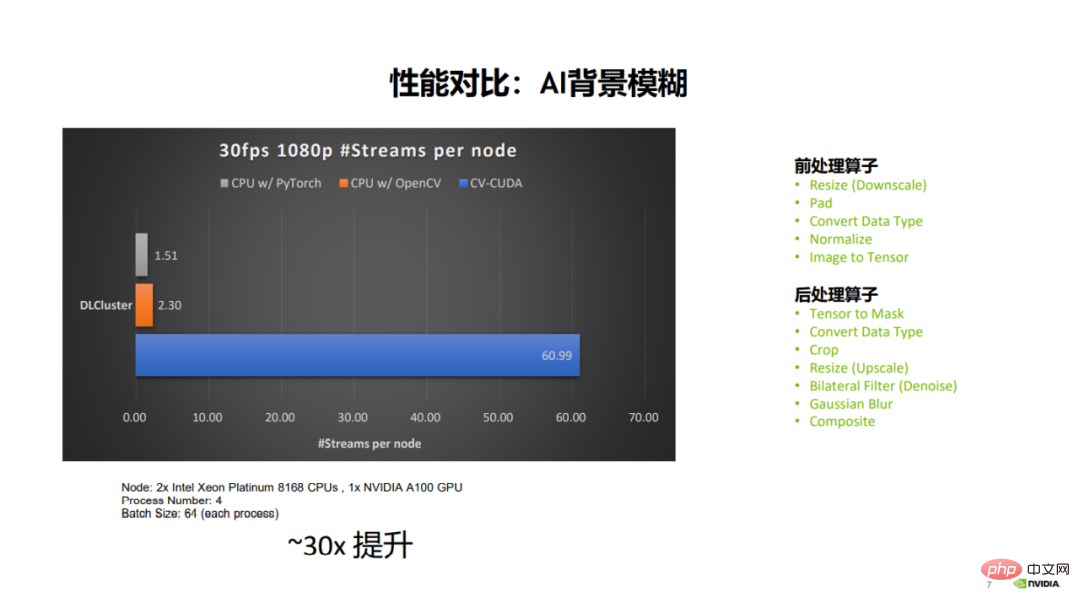
After migrating the entire process to the GPU, the entire pipeline can be improved by nearly 30 times, thus Save computing overhead and reduce operating costs.
It can be seen from the comparison of the data in the figure that under the same server and parameter configuration, OpenCV can open up to 2-3 30fps 1080p video streams. For parallel streams, PyTorch (CPU) can open up to 1.5 parallel streams, while CV-CUDA can open up to 60 parallel streams. It can be seen that the overall performance improvement is very large. The pre-processing operators involved include resize, padding, normalize, etc., and the post-processing operators include crop, resize, compose, etc.
3. Asynchronousization
Why GPU can adapt to the acceleration needs of pre- and post-processing ? Benefit from the asynchronous between model calculation and pre- and post-processing, and adapt to the parallel computing capabilities of GPU.
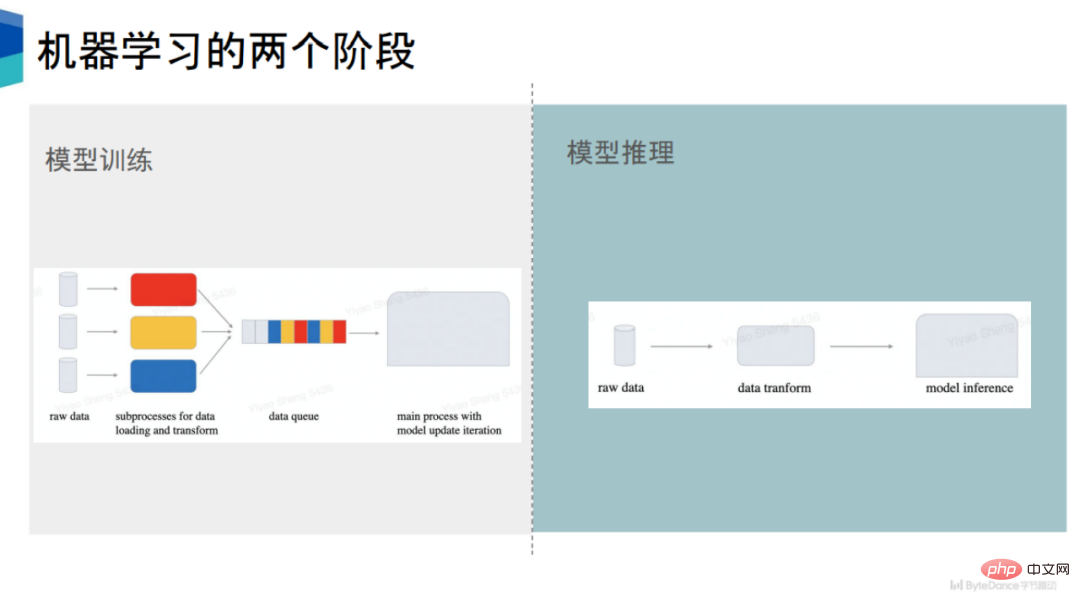
##We The preprocessing asynchronousization of model training and model inference is explained separately.
1. Preprocessing asynchronousization of model training
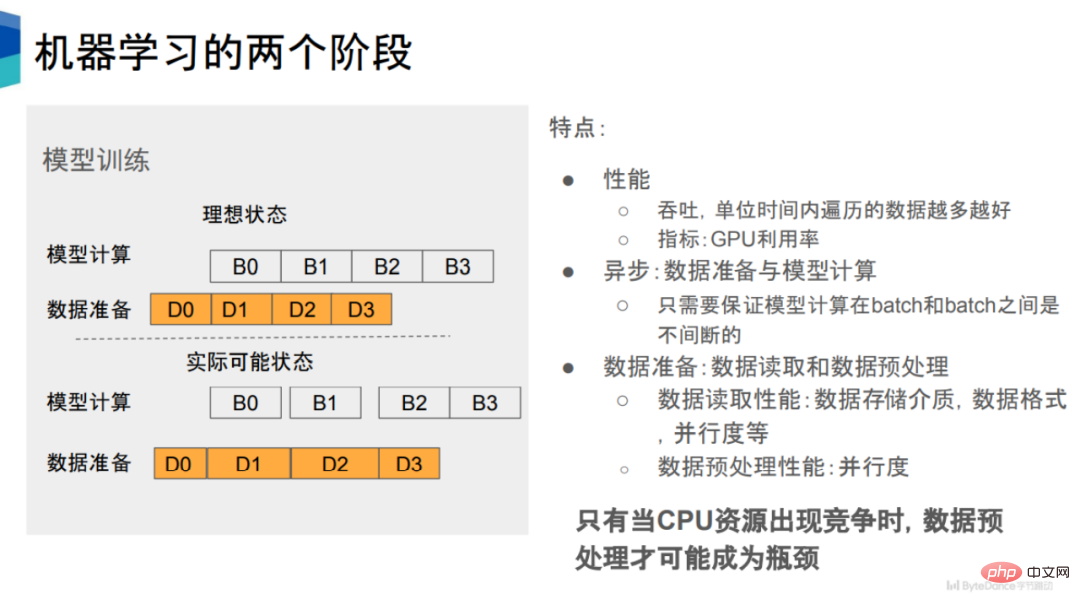
##Model training can be divided into two parts, the first is data preparation, and the second is model calculation. The current mainstream machine learning frameworks, such as PyTorch and TensorFlow, are asynchronous between data preparation and model calculation. Taking PyTorch as an example, it will start multiple sub-processes for data preparation. As shown in the figure, it contains two states, namely model calculation and data preparation. There is a time sequence relationship between the two. For example, when D0 is completed, You can proceed to B0, and so on. #From a performance perspective, we expect the speed of data preparation to keep up with the speed of model calculation. However, in actual situations, some data reading and data preprocessing processes take a long time, resulting in a certain window period before corresponding model calculations can be performed, resulting in a decrease in GPU utilization. Data preparation can be divided into data reading and data preprocessing. These two stages can be executed serially or in parallel, such as under the PyTorch framework. It is executed serially. There are many factors that affect the performance of data reading, such as data storage media, storage format, parallelism, number of execution processes, etc. In contrast, The factor that affects the performance of data preprocessing is relatively simple, which is the degree of parallelism. The higher the degree of parallelism, the better the performance of data preprocessing. In other words, making data preprocessing and model calculation asynchronous and increasing the parallelism of data preprocessing can improve the performance of data preprocessing. 2. Preprocessing asynchronousization of model inference
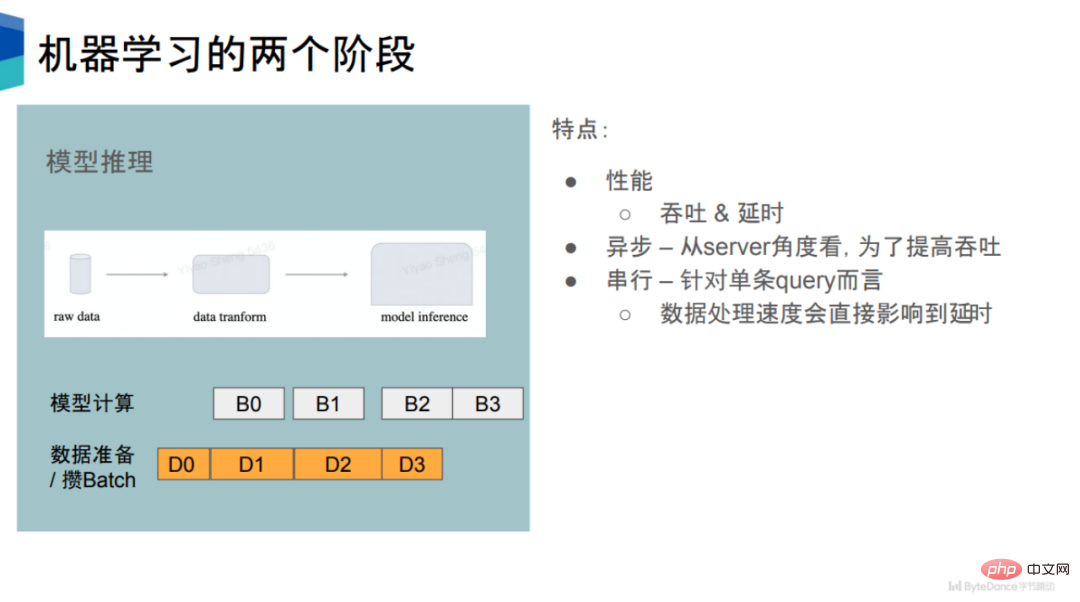
In In the model inference phase, its performance has two indicators, the first is throughput, and the second is delay. To a certain extent, these two indicators are mutually exclusive.
For a single query, after the server receives the data, it will preprocess the data and then perform model inference. So for a single query, it is a serial process to a certain extent.
But this is very inefficient and will waste a lot of computing resources. In order to improve throughput, many inference engines will use the same strategy as the training phase to asynchronously prepare data and model calculations. In the data preparation phase, a certain amount of queries will be accumulated and combined into a batch, and then subsequent calculations will be performed to improve the overall throughput.
In terms of throughput, model inference and model training are relatively similar. By moving the data preprocessing stage from the CPU to the GPU, throughput gains can be achieved.
At the same time, from the perspective of delay, for each query statement, if the time spent in the preprocessing process can be reduced, the delay for each query will be shortened accordingly.
Another feature of model reasoning is that the amount of model calculation is relatively small, because it only involves forward calculation and not backward calculation. This means that model inference requires higher data preprocessing.
3. Core issue: CPU resource competition
Assuming there are enough CPU resources for calculation, theoretically preprocessing will not become Performance bottleneck. Because once you find that the performance cannot keep up, you only need to add processes to do preprocessing operations.
Therefore, data preprocessing may become a performance bottleneck only when there is competition for CPU resources.
In actual business, competition for CPU resources is very common, which will lead to reduced GPU utilization in subsequent training and inference stages, and thus reduced training speed.
As GPU computing power continues to increase, it is foreseeable that the speed requirements for the data preparation phase will become higher and higher.
For this reason, it is a natural choice to move the preprocessing part to the GPU to alleviate the problem of CPU resource competition and improve GPU utilization.
Overall, this design reduces the complexity of the system and directly adapts the main body of the model pipeline to the GPU, which can greatly help improve the utilization of both GPU and CPU. At the same time, it also avoids the problem of result alignment between different versions, reduces dependencies, and conforms to the software design principles proposed by John Ousterhout.
4. CV-CUDA
Moving the pre-processing and post-processing processes to the GPU needs to meet multiple requirements condition.
#The first is that its performance must be at least better than that of the CPU. This is mainly based on the high concurrent computing capabilities of GPUs.
#The second is to accelerate preprocessing and not have a negative impact on other processes such as model inference. For the second requirement, each operator of CV-CUDA has an interface between stream and CUDA memory, so that the GPU resources can be allocated more reasonably, so that when running these preprocessing operators on the GPU, it will not have too much impact. to the model calculation itself.
Thirdly, Internet companies have very diverse business needs, involving many types of models, and corresponding preprocessing logic. Therefore, preprocessing calculations Subclasses need to be developed to be customized, allowing greater flexibility to implement complex logic.
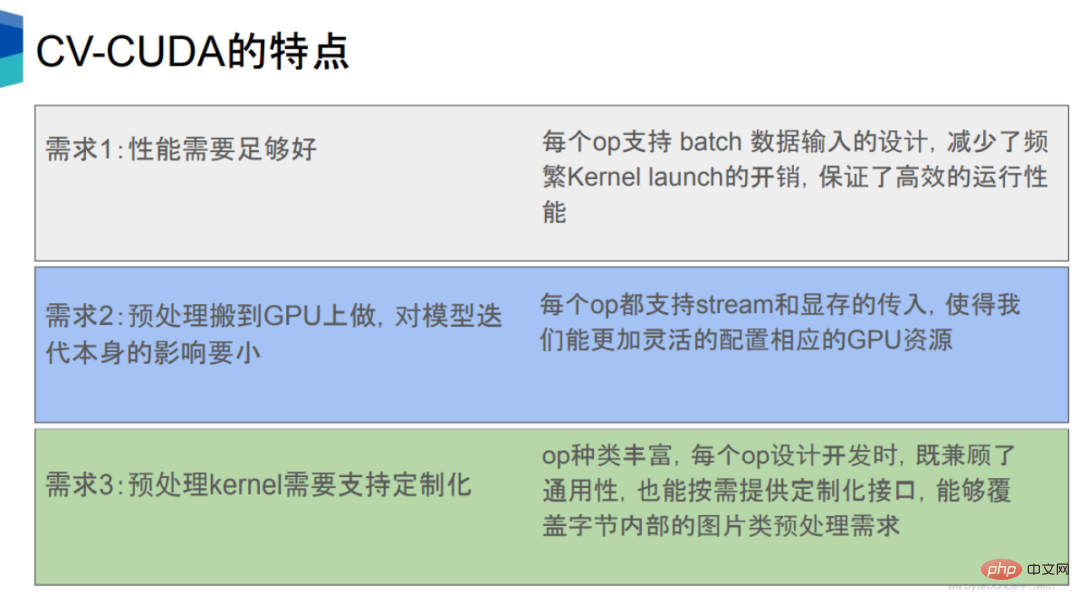
Generally speaking, CV-CUDA analyzes the model pipeline from the aspects of hardware, software, algorithm, language, etc. The pre- and post-processing stages are accelerated and the entire pipeline is unified.
1. Hardware
In terms of hardware, CV-CUDA is based on the parallel computing capabilities of the GPU, which can greatly improve the speed and throughput of pre- and post-processing and reduce the number of models. Compute waiting time and improve GPU utilization.
CV-CUDA supports Batch and Variable Shape modes. Batch mode supports batch processing and can take full advantage of the parallel characteristics of the GPU. However, OpenCV can only call a single image regardless of whether it is the CPU or GPU version.
Variable Shape mode means that in a batch, the length and width of each picture can be different. The length and width of images on the Internet are generally inconsistent. The mainstream framework method is to resize the length and width to the same size respectively, then package the images of the same length and width into a batch, and then process the batch. CV-CUDA can directly put images of different lengths and widths into a batch for processing, which not only improves efficiency, but is also very convenient to use.
Another meaning of Variable Shape is that when processing images, you can specify certain parameters of each image, such as rotate. For a batch of images, you can specify the rotation angle of each image.
2. Software
#In terms of software, CV-CUDA has developed a large number of software optimization methods for further optimization, including performance optimization. (such as memory access optimization) and resource utilization optimization (such as video memory pre-allocation), so that it can run efficiently in cloud training and inference scenarios.
#The first is the video memory pre-allocation setting. When OpenCV calls the GPU version, some operators will execute cudaMalloc internally, which will cause a significant increase in time consumption. In CV-CUDA, all video memory pre-allocation is performed during the initialization phase, while during the training and inference phases, no video memory allocation operations are performed, thereby improving efficiency.
#Secondly, all operators operate asynchronously. CV-CUDA integrates a large number of kernels, thereby reducing the number of kernels, thereby reducing kernel startup time and data copy and erasure, and improving overall operating efficiency.
Thirdly, CV-CUDA also optimizes memory access, such as merging memory access, vectorized reading and writing, etc., to improve bandwidth utilization and also Use shared memory to improve memory access, read and write efficiency.
Finally, CV-CUDA has also made a lot of optimizations in calculations, such as fast math, warp reduce/block reduce, etc.
3. Algorithm
In terms of algorithm, CV-CUDA’s operators are independently designed and customized to support Very complex logic implementation and easy to use and debug.
How to understand independent design? There are two forms of operator calling in the image processing library. One is the overall pipeline form, which can only obtain the results of the pipeline, such as DALI, and the other is the modular independent operator form, which can obtain each operator. Individual results, such as OpenCV. CV-CUDA uses the same calling form as OpenCV, which is more convenient to use and debug.
4. Language
#In terms of language, CV-CUDA supports a rich API, which can seamlessly connect pre- and post-processing to training and inference scenarios. .
These APIs include commonly used C, C, Python interfaces, etc., which allows us to support both training and inference scenarios. It also supports PyTorch and TensorRT. Interface, in the future, CV-CUDA will also support interfaces such as Triton, TensorFlow, and JAX.
In the inference stage, you can directly use the Python or C interface for inference, as long as you ensure that the pre- and post-processing, model, and GPU are placed on the same stream during inference. Can.
5. Application Cases
By demonstrating the use of CV-CUDA in NVIDIA, NVIDIA, and From the application cases of Jiedong and Sina Weibo, we can realize how significant the performance improvement brought by CV-CUDA is.
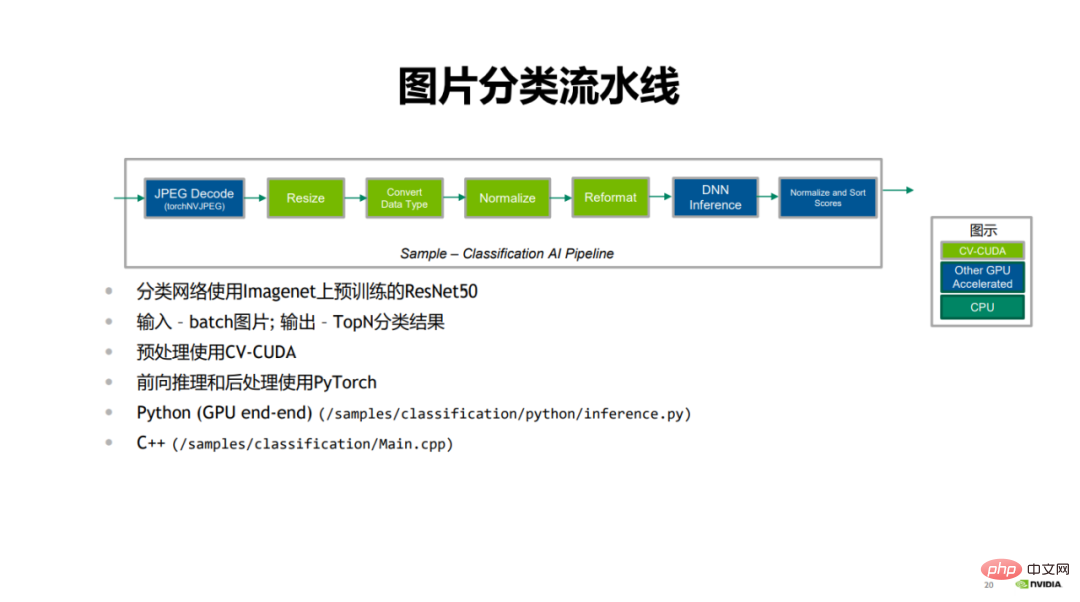
The first is the image classification case shown by NVIDIA.
In the image classification pipeline, the first is JPEG decode, which decodes the image; the green part is the pre-processing step, including resize, convert data type, normalize and reformat; the blue part is the forward reasoning process using PyTorch, and finally the classification results are scored and sorted.
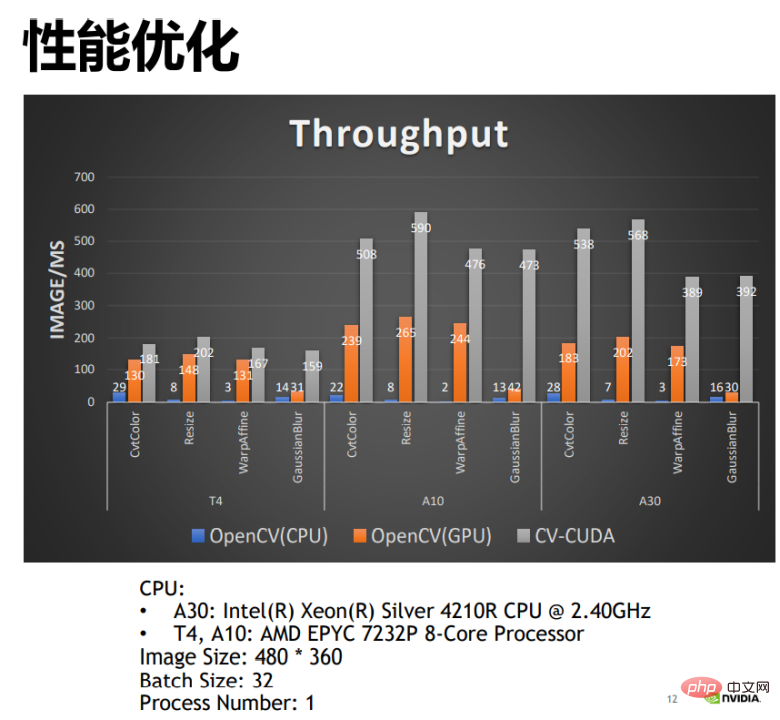
Comparing the performance of the CPU version and GPU version of CV-CUDA and OpenCV can be found , the GPU version of OpenCV can achieve greater performance improvement compared to the CPU version, and by applying CV-CUDA, the performance can be doubled. For example, the number of images processed by OpenCV's CPU operator per millisecond is 22, and the number of images processed by the GPU operator per millisecond is more than 200. CV-CUDA can process more than 500 images per millisecond, and its throughput is that of OpenCV's CPU. It is more than 20 times that of the GPU version and twice that of the GPU version. The performance improvement is obvious.
#The second is the three cases of OCR1, OCR2, and video multi-modality presented by ByteDance.
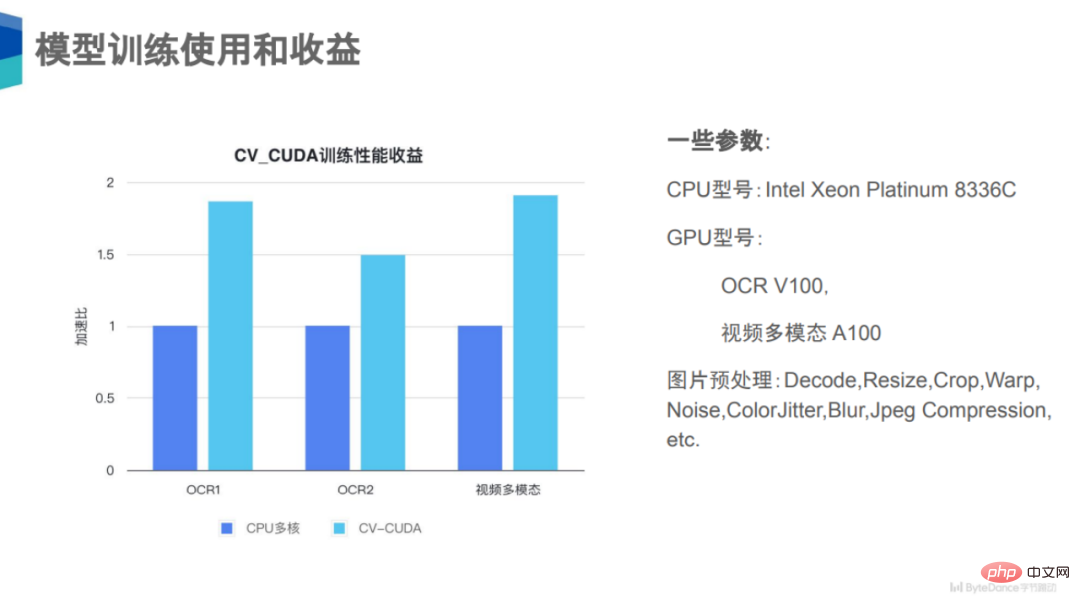
In model training, you can see that in OCR1, OCR2, video multi-modal On three tasks, performance gains of 50% to 100% were obtained after using CV-CUDA.
Why is there such a big performance gain? In fact, one thing these three tasks have in common is that their image preprocessing logic is very complex, such as decode, resize, crop, etc., and these are still large categories. In fact, there may be many smaller ones in each operator category. Class or subclass preprocessing. For these three tasks, there may be more than a dozen types of data enhancement on the preprocessing link, so the computational pressure on the CPU is very high. If this part of the calculation can be moved to the GPU, the CPU's Resource competition will be significantly reduced, and the overall throughput will be greatly improved.
#Finally, there is a video processing case shown on Sina Weibo.
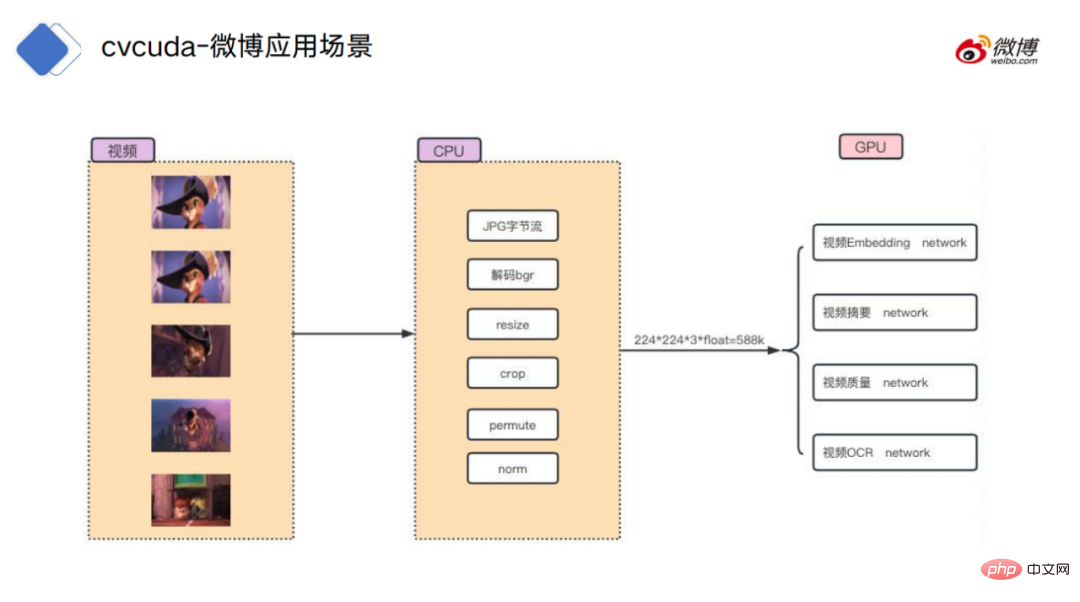
For the video processing process, the traditional approach is to first put the video frames in the CPU environment Decoding: decode the original byte stream into image data, then perform some regular operations, such as resize, crop, etc., and then upload the data to the GPU for specific model calculations.
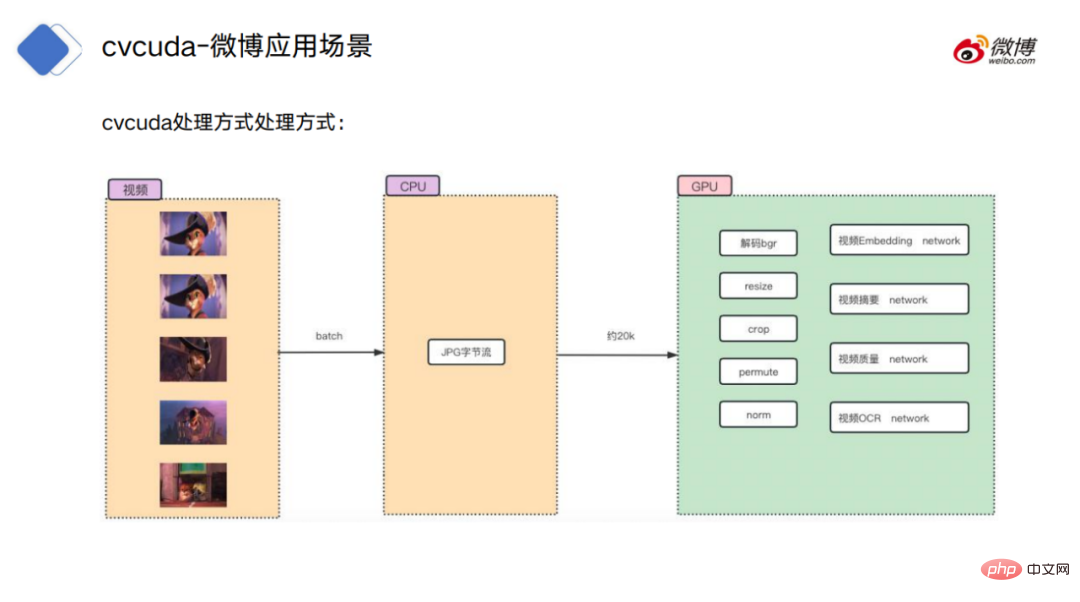
The processing method of CV-CUDA is to decode the CPU and put it in the memory. The byte stream is uploaded to the GPU, and the preprocessing is also located on the GPU, so that it can be seamlessly connected with the model calculation without the need for copy operations between the video memory and the memory.

The figure shows the use of OpenCV (odd numbers) and CV-CUDA (even numbers) Respective processing time, blue refers to the consumption time of the model, orange refers to the consumption time of decoding, and green refers to the consumption time of preprocessing.
OpenCV can be divided into two modes: CPU decoding and GPU decoding. CV-CUDA only uses GPU decoding mode.
#It can be seen that for CPU-decoded OpenCV, OpenCV’s decoding and preprocessing are much more time-consuming than CV-CUDA.
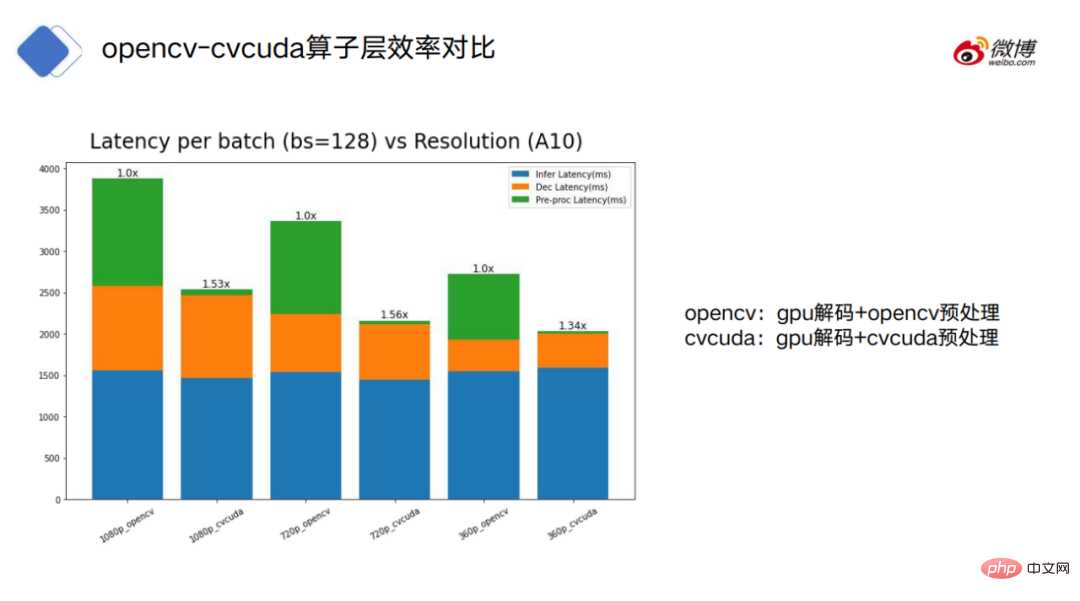
Looking at the case of OpenCV using GPU decoding, we can see that OpenCV and CV- The time consuming of CUDA in the model and decoding parts is close, but there is still a big gap in preprocessing.
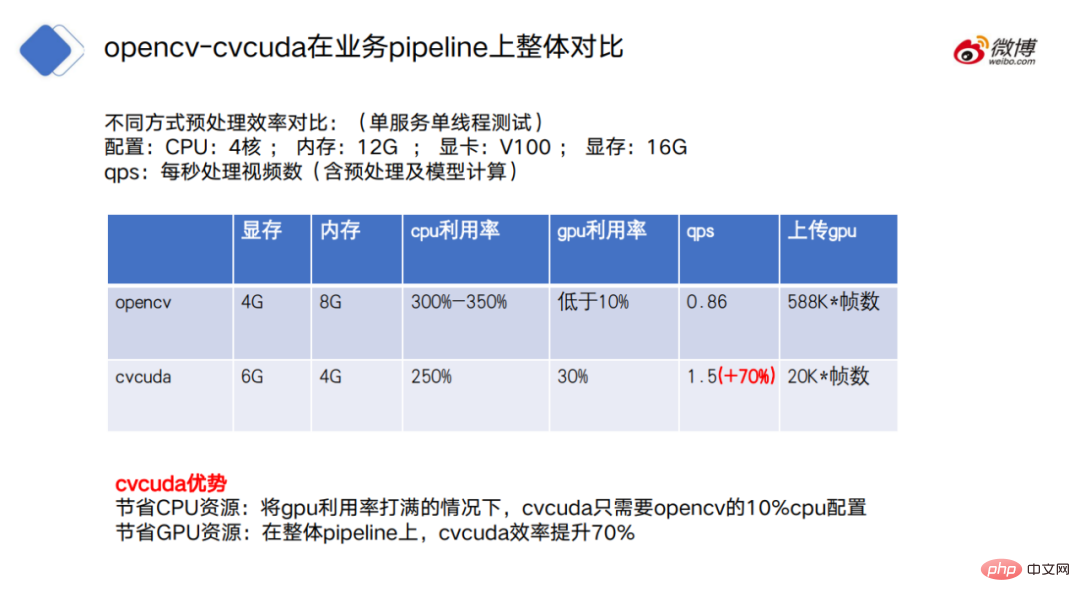
##In terms of overall pipeline comparison, CV-CUDA also has obvious advantages. On the one hand CV-CUDA saves more CPU resources, that is, when the GPU utilization is full, CV-CUDA only requires 10% of the CPU configuration of OpenCV; at the same time, CV-CUDA also saves more GPU resources. In the overall pipeline, CV- CUDA efficiency increased by 70%.
6. Future Outlook
CV-CUDA can effectively solve the problem of CPU in both model training and inference stages. The problem of resource competition can improve the efficiency of model training and inference. But how to correctly understand the advantages of CV-CUDA? It is necessary to understand the fundamental premise for its function, and its advantages over CPU and OpenCV are not absolute. First of all, CV-CUDA is actually not a panacea. For example, in the model training stage, if the bottleneck is not in preprocessing, but in data reading and model inference. At this time, if you use CV-CUDA to replace the original preprocessing solution, it is actually of no use. In addition, in the process of using CV-CUDA, if the workload of the CPU and GPU is reasonably allocated to the preprocessing logic, sometimes better performance results can be achieved.For example, the CPU can still decode and resize images, and then put them on the GPU for processing after resizing.
Why put decoding and resize on the CPU? First of all, for image decoding, the GPU’s hard decoding unit is actually limited. Secondly, for resize, usually resize will convert a larger picture into a smaller picture.
If the data is copied to the GPU before resize, it may occupy a lot of bandwidth for video memory data transfer.
Of course, how to allocate the workload between the CPU and GPU still needs to be judged based on the actual situation.
The most important principle is not to alternate calculations between CPU and GPU, because there is overhead in transmitting data across devices. If the alternation is too frequent, the benefits brought by the calculation itself may be flattened, resulting in a decrease in performance instead of an increase.
In December 2022, CV-CUDA released the alpha version, which contains more than 20 operators, such as commonly used Flip, Rotate, Perspective, Resize, etc. .
Currently OpenCV has more operators, with thousands of operators. CV-CUDA currently only accelerates the more commonly used operators, and will continue to do so in the future. Add new operators.
CV-CUDA will also release a beta version in March this year, which will add more than 20 operators to more than 50 operators. The beta version will include some very commonly used operators, such as ConvexHull, FindContours, etc.

##Seven, End
Return Looking back at the design plan of CV-CUDA, we can find that there are not too complicated principles behind it, and it can even be said to be clear at a glance.
#From a complexity perspective, this can be said to be the advantage of CV-CUDA. "The Philosophy of Software Design" mentions a principle for judging software complexity - if a software system is difficult to understand and modify, it is very complex; if it is easy to understand and modify, it is very simple.
The effectiveness of CV-CUDA can be understood as the adaptability of the model calculation stage to the GPU, which drives the adaptability of the pre- and post-processing stages to the GPU. . And this trend has actually just begun.
The above is the detailed content of Throughput increased by 30 times: CV pipeline moves toward full-stack parallelization. For more information, please follow other related articles on the PHP Chinese website!

Hot AI Tools

Undresser.AI Undress
AI-powered app for creating realistic nude photos

AI Clothes Remover
Online AI tool for removing clothes from photos.

Undress AI Tool
Undress images for free

Clothoff.io
AI clothes remover

Video Face Swap
Swap faces in any video effortlessly with our completely free AI face swap tool!

Hot Article

Hot Tools

Notepad++7.3.1
Easy-to-use and free code editor

SublimeText3 Chinese version
Chinese version, very easy to use

Zend Studio 13.0.1
Powerful PHP integrated development environment

Dreamweaver CS6
Visual web development tools

SublimeText3 Mac version
God-level code editing software (SublimeText3)

Hot Topics
 The difference between single-stage and dual-stage target detection algorithms
Jan 23, 2024 pm 01:48 PM
The difference between single-stage and dual-stage target detection algorithms
Jan 23, 2024 pm 01:48 PM
Object detection is an important task in the field of computer vision, used to identify objects in images or videos and locate their locations. This task is usually divided into two categories of algorithms, single-stage and two-stage, which differ in terms of accuracy and robustness. Single-stage target detection algorithm The single-stage target detection algorithm converts target detection into a classification problem. Its advantage is that it is fast and can complete the detection in just one step. However, due to oversimplification, the accuracy is usually not as good as the two-stage object detection algorithm. Common single-stage target detection algorithms include YOLO, SSD and FasterR-CNN. These algorithms generally take the entire image as input and run a classifier to identify the target object. Unlike traditional two-stage target detection algorithms, they do not need to define areas in advance, but directly predict
 Application of AI technology in image super-resolution reconstruction
Jan 23, 2024 am 08:06 AM
Application of AI technology in image super-resolution reconstruction
Jan 23, 2024 am 08:06 AM
Super-resolution image reconstruction is the process of generating high-resolution images from low-resolution images using deep learning techniques, such as convolutional neural networks (CNN) and generative adversarial networks (GAN). The goal of this method is to improve the quality and detail of images by converting low-resolution images into high-resolution images. This technology has wide applications in many fields, such as medical imaging, surveillance cameras, satellite images, etc. Through super-resolution image reconstruction, we can obtain clearer and more detailed images, which helps to more accurately analyze and identify targets and features in images. Reconstruction methods Super-resolution image reconstruction methods can generally be divided into two categories: interpolation-based methods and deep learning-based methods. 1) Interpolation-based method Super-resolution image reconstruction based on interpolation
 How to use AI technology to restore old photos (with examples and code analysis)
Jan 24, 2024 pm 09:57 PM
How to use AI technology to restore old photos (with examples and code analysis)
Jan 24, 2024 pm 09:57 PM
Old photo restoration is a method of using artificial intelligence technology to repair, enhance and improve old photos. Using computer vision and machine learning algorithms, the technology can automatically identify and repair damage and flaws in old photos, making them look clearer, more natural and more realistic. The technical principles of old photo restoration mainly include the following aspects: 1. Image denoising and enhancement. When restoring old photos, they need to be denoised and enhanced first. Image processing algorithms and filters, such as mean filtering, Gaussian filtering, bilateral filtering, etc., can be used to solve noise and color spots problems, thereby improving the quality of photos. 2. Image restoration and repair In old photos, there may be some defects and damage, such as scratches, cracks, fading, etc. These problems can be solved by image restoration and repair algorithms
 Scale Invariant Features (SIFT) algorithm
Jan 22, 2024 pm 05:09 PM
Scale Invariant Features (SIFT) algorithm
Jan 22, 2024 pm 05:09 PM
The Scale Invariant Feature Transform (SIFT) algorithm is a feature extraction algorithm used in the fields of image processing and computer vision. This algorithm was proposed in 1999 to improve object recognition and matching performance in computer vision systems. The SIFT algorithm is robust and accurate and is widely used in image recognition, three-dimensional reconstruction, target detection, video tracking and other fields. It achieves scale invariance by detecting key points in multiple scale spaces and extracting local feature descriptors around the key points. The main steps of the SIFT algorithm include scale space construction, key point detection, key point positioning, direction assignment and feature descriptor generation. Through these steps, the SIFT algorithm can extract robust and unique features, thereby achieving efficient image processing.
 Interpretation of the concept of target tracking in computer vision
Jan 24, 2024 pm 03:18 PM
Interpretation of the concept of target tracking in computer vision
Jan 24, 2024 pm 03:18 PM
Object tracking is an important task in computer vision and is widely used in traffic monitoring, robotics, medical imaging, automatic vehicle tracking and other fields. It uses deep learning methods to predict or estimate the position of the target object in each consecutive frame in the video after determining the initial position of the target object. Object tracking has a wide range of applications in real life and is of great significance in the field of computer vision. Object tracking usually involves the process of object detection. The following is a brief overview of the object tracking steps: 1. Object detection, where the algorithm classifies and detects objects by creating bounding boxes around them. 2. Assign a unique identification (ID) to each object. 3. Track the movement of detected objects in frames while storing relevant information. Types of Target Tracking Targets
 An introduction to image annotation methods and common application scenarios
Jan 22, 2024 pm 07:57 PM
An introduction to image annotation methods and common application scenarios
Jan 22, 2024 pm 07:57 PM
In the fields of machine learning and computer vision, image annotation is the process of applying human annotations to image data sets. Image annotation methods can be mainly divided into two categories: manual annotation and automatic annotation. Manual annotation means that human annotators annotate images through manual operations. This method requires human annotators to have professional knowledge and experience and be able to accurately identify and annotate target objects, scenes, or features in images. The advantage of manual annotation is that the annotation results are reliable and accurate, but the disadvantage is that it is time-consuming and costly. Automatic annotation refers to the method of using computer programs to automatically annotate images. This method uses machine learning and computer vision technology to achieve automatic annotation by training models. The advantages of automatic labeling are fast speed and low cost, but the disadvantage is that the labeling results may not be accurate.
 Examples of practical applications of the combination of shallow features and deep features
Jan 22, 2024 pm 05:00 PM
Examples of practical applications of the combination of shallow features and deep features
Jan 22, 2024 pm 05:00 PM
Deep learning has achieved great success in the field of computer vision, and one of the important advances is the use of deep convolutional neural networks (CNN) for image classification. However, deep CNNs usually require large amounts of labeled data and computing resources. In order to reduce the demand for computational resources and labeled data, researchers began to study how to fuse shallow features and deep features to improve image classification performance. This fusion method can take advantage of the high computational efficiency of shallow features and the strong representation ability of deep features. By combining the two, computational costs and data labeling requirements can be reduced while maintaining high classification accuracy. This method is particularly important for application scenarios where the amount of data is small or computing resources are limited. By in-depth study of the fusion methods of shallow features and deep features, we can further
 Distributed Artificial Intelligence Conference DAI 2024 Call for Papers: Agent Day, Richard Sutton, the father of reinforcement learning, will attend! Yan Shuicheng, Sergey Levine and DeepMind scientists will give keynote speeches
Aug 22, 2024 pm 08:02 PM
Distributed Artificial Intelligence Conference DAI 2024 Call for Papers: Agent Day, Richard Sutton, the father of reinforcement learning, will attend! Yan Shuicheng, Sergey Levine and DeepMind scientists will give keynote speeches
Aug 22, 2024 pm 08:02 PM
Conference Introduction With the rapid development of science and technology, artificial intelligence has become an important force in promoting social progress. In this era, we are fortunate to witness and participate in the innovation and application of Distributed Artificial Intelligence (DAI). Distributed artificial intelligence is an important branch of the field of artificial intelligence, which has attracted more and more attention in recent years. Agents based on large language models (LLM) have suddenly emerged. By combining the powerful language understanding and generation capabilities of large models, they have shown great potential in natural language interaction, knowledge reasoning, task planning, etc. AIAgent is taking over the big language model and has become a hot topic in the current AI circle. Au





